
11 minute read
FIET
Rapid Freezing of Sheep Milk
Jolin Morel 1 , Lindsay Robertson 1 , Richard Archer 1, 2 1. School of Food & Advanced Technology, Massey University, 2. Riddet Institute
Richard Archer, Jolin Morel, Lindsay Robertson (of Massey) and Ian Macdonald of Sheep Milk Supply Group
The storage of frozen ovine milk We started this project four years ago in support of the sheep milk industry which was clearly growing at pace but needed help. Both existing and new farmers were scattered around New Zealand, interested in entering the industry. Many aimed at milking only a few hundred sheep to yield under 1000 L of milk per day. But this is far too little to support a spray dryer or a cheese business of significance. Clearly, for this industry to grow, there needed to be some means of aggregating these small lots of milk in time and space. We needed to preserve milk and transport it safely to central processors. Ideally farmers would have a standardised tradeable method for preserving their milk for sale. Right from the beginning of the sheep and goat milk industries farmers had frozen their milk usually in plastic bladders of 2 to 10 L, sometimes in pails. This works for the farmer and is convenient. But it means freezing is very slow and thawing is slow. And that compromises quality and makes handling difficult for the processor. We sought, in this project, to devise an affordable and simple, compact freezing method to form small balls, flakes or pellets of milk ice very rapidly and securely. We hoped that such a freezer could also be useful for other applications like freezing fruit pulps, blood, plasma etc.
The storage of frozen ovine milk We started work by investigating the reported quality losses due to slow freezing. We measured the impact of storage temperature on loss in protein stability by comparing milk samples stored at -10°C, -18°C, and -30°C for 9 weeks. After thawing at 20°C, the samples were centrifuged, and the amount of precipitate measured. There was no sediment noticeable in samples stored at -18°C or at -30°C. However those samples which were stored at -10°C formed a gel, which entrapped fat globules in the milk. The viscosity of milk stored at -10°C also increased greatly, and the milk became shear-thinning, rather than remaining Newtonian like the milk stored at lower temperatures. The serum Ca 2+ level in milk stored at -10°C was lower than in the fresh milk, indicating that the mineral balance of the milk was disrupted at the higher storage temperature.
Storage at lower temperatures clearly led to better quality in the frozen product. The thermodynamics of freezing sheep milk and the kinetics of protein destabilisation. Freezing point depression is a well know property of solutions, where the presence of solutes reduces the freezing point of a sample, and increased concentrations decrease the freezing point further. In sheep milk, the equilibrium freezing temperature is decreased from 0°C to -0.57°C by the milk solids normally present.
When an ice crystal grows in a solution it forms a stable crystalline structure that tends to reject solutes. Rejected solutes travel into the solution, and further decrease its freezing point. This means that food solutions such as milk freeze progressively, over a wide range of temperatures. This can be studied by differential scanning calorimetry (DSC), where a sample is heated at a fixed rate and the rates of energy flow into and out of the sample are measured. We did this with sheep milk and sheep milk fractions, heating samples from -40°C to 25°C at 1°C/ minute.
A curve from these measurements is shown in Figure 1. We then used the recorded enthalpy data to determine how much latent heat of melting was released at any temperature, and from that we calculated the amount of unfrozen water in the sheep milk.
The DSC measurements also allowed transitions such as the glass transition or melting onset to be detected. A glass transition occurs when a glassy solid becomes rubbery, and a melting onset occurs in highly concentrated solutions, when the viscosity of the solution drops low enough that ice can form (roughly 10 8 Pa.s). This happens at concentrations and temperatures that vary from solution to solution.
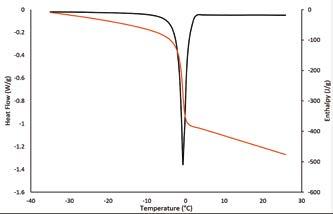
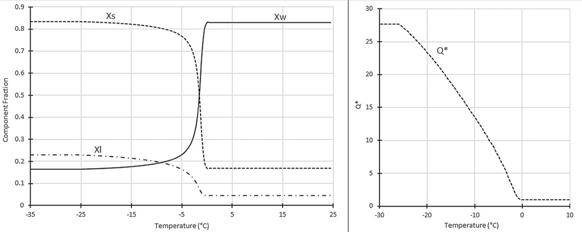
In whole sheep milk, the melting onset temperature was measured at -25°C. The solids concentration of the unfrozen milk at this point was a massive 85±1.6%. The solids, water, and lactose fractions in the unfrozen fraction of milk for a range of temperatures are shown in Figure 2, as is the concentration factor on a g solids /g water basis. DSC measurements allow a partial phase diagram of sheep milk to be constructed, as shown in Figure 3. The composition of the unfrozen phase, which is shown in Figure 2, and the transitions detected by DSC and shown in Figure 3 can help to explain the kinetics of the protein destabilisation seen during frozen storage.
Research suggests that the major causes of protein destabilisation are the physical aggregation of micelles after rejection from growing ice crystals, reduced protein stability at lower temperatures, and the increased concentration of salts in the unfrozen phase. However, the forces which drive protein destabilisation are present in milk stored at lower temperatures as well as in milk stored at -10°C. For example, the concentration factor of milk at -30°C, Q*= 27.7 was larger than that at -10°C, when Q*=13.9, which would increase some reaction rates in absence of an increase in viscosity. The clear difference between the lower storage temperatures, where milk is more stable, and -10°C is the viscosity of the unfrozen phase. Assuming the viscosity in the concentrated unfrozen phase follows the Williams-Landel-Ferry model, it will increase rapidly as the temperature decreases to near the glass transition temperature. As discussed above, in whole sheep milk a melting onset is seen at -25°C, and the glass transition will occur at -35°C. This means that the viscosity at -30°C is at least 6 orders of magnitude higher than at -10°C. This large increase in viscosity has several effects. The diffusion of mineral into the gel, which can stabilise protein interlinkages, will be much slower, as diffusion rates are inversely proportional to solvent viscosity. Similarly, fat oxidation will slow down as oxygen diffusion to milk fat is retarded. Proteins within the milk will be much less mobile in the highly viscous environment at -30°C, which will slow any reactions or rearrangements between proteins. Enzymatic reactions will be slower, so any lipolytic enzymes in the milk will degrade fats less at -30°C; and lactose crystallisation is suppressed, because crystallisation is dependent on solute diffusion to crystal nuclei. Lactose acts as a cryoprotectant in frozen products, so frozen samples which keep lactose in solution will be more stable than those where lactose crystallises out. Reaction rates which follow Arrhenius kinetics would also be reduced as the temperature decreases from -10°C to -30°C, but the magnitude of this reduction is lower than the magnitude of the viscosity increase. Freezing methods which rapidly achieve low temperatures can maintain quality better as the milk spends less time at elevated temperatures where unwanted effects like lactose crystallisation or mineral migration can occur. We have observed lactose crystals by cryo-SEM in some slowly frozen samples, but not in rapidly frozen samples. Figure 2: Component fractions in the unfrozen fraction in whole sheep milk during freezing. Xs, the total solid fraction, Xw, the water fraction, and Xi, the lactose fraction. The concentration factor Q* is also shown
Figure 3: Partial Phase Diagram for ovine milk. T g estimated from the Gordon-Taylor equation fits for whole bovine milk. T f and T m determined from DSC study, and X s (T m ) estimated from energy release during the freezing process. T g estimated from the Gordon-Taylor equation and X s (T m )
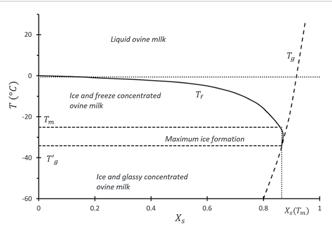
The ice structure of frozen milk The speed of freezing affects the ice structure, which can affect the milk quality. This was studied in sheep milk by transmission light microscopy. Sheep milk was sandwiched between 2 sheets of glass in a customised microscope stage, and the ice/milk interface was observed at ice growth rates from 0.5µms -1 to 40µms -1 .
At low ice growth rates (0.5µms -1 ) the interface is planar, and milk solids are rejected from the growing ice front, leading to an increased concentration in the unfrozen phase. At high freezing front velocities (above 30 µms -1 ), the growth is dendritic, with milk solids being trapped in regions between ice crystal branches and no gross separation occurring. The spacing of features in an advancing ice front decreases as the ice front speed increases. This can be seen in the images of ice fronts in Figure 4.
The effect of freezing speed can also be seen in images of milk frozen rapidly and frozen slowly, that were collected by Cryo-SEM (Figure 5). In the slowly frozen samples, solutes have been rejected into thick bands between large ice crystals, and no engulfing of fat globules in ice crystals is seen. In the rapidly frozen samples the bands of solute are thinner and some fat globules are entrapped by ice crystals. The average thickness of milk solids bands differs between the two samples, with the bands being 55± 49 µm thick in slowly frozen samples, compared with 3.2±1.5 µm for rapidly frozen milk samples. The size of these milk solids bands can influence the size of any protein aggregates formed during frozen storage, affecting sensory acceptability of freeze-thawed milk: soft particles above approximately 80µm in
size can be perceived as “gritty”, as can hard particles above 20µm (Guinard & Mazzucchelli, 1996). The slowly frozen samples could indeed form aggregates larger than 80µm, which would be perceptible. However the thinner solids bands in rapidly frozen milk would limit any aggregates to skinny flakes less than 5 µm thick - these would have little effect on perceived texture and would scatter light well enough to give a good white milk on thawing. The thawing of sheep milk Of course, freezing and frozen storage is only part of the challenge. Milk must be thawed if it is to be used for food products, and rapid freezing methods can help the thawing process. Milk that is frozen in large blocks or buckets can take a very long time to thaw. Tests and simulations have both shown that a 10L bucket filled with frozen milk can take up to 3 days to thaw completely when simply left in a room at about 20°C. Such long thawing times lead to increased microbial growth. Only frozen milk volumes smaller than 1L can avoid unacceptable microbial growth when thawed at room temperature (Tribst, Falcade, & de Oliveira, 2019). Long thawing times also result in reduced quality product due to the progressive thawing of components that have been segregated by the initial slow freezing. Rapid freezing in the right equipment can make small chunks of milk ice. Their low characteristic distance lets them thaw in a matter of minutes, rather than hours and further reduces the risk of microbial growth and spoilage. New Zealand’s large cow milk industry could yet be the biggest user, lopping peaks off in the flush and capturing milk from the best producers in the herd for two more weeks after the bulk have dried off. Or capturing special milks from special farms for occasional processing when capacity is available. Watch this space. References Guinard, J.-X., & Mazzucchelli, R. (1996). The sensory perception of texture and mouthfeel. Trends in Food Science & Technology, 7(7), 213-219. https://doi.org/10.1016/0924-2244(96)10025-X Tribst, A. A. L., Falcade, L. T. P., & de Oliveira, M. M. (2019). Strategies for raw sheep milk storage in smallholdings: Effect of freezing or longterm refrigerated storage on microbial growth. J Dairy Sci 10.3168/ jds.2018-15715 Figure 4: Ice front morphologies observed at a range of ice front velocities in skim sheep milk Figure 5: Comparison between the frozen structure of sheep milk frozen rapidly (left) and frozen slowly(right)
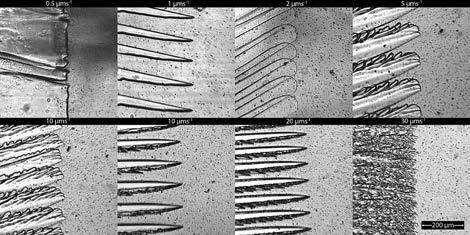
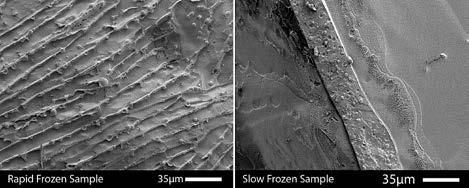
The rapid freezer All our work on freezing and thawing of sheep milk has one purpose: to help us develop a rapid freezer for use on or near farms in New Zealand. Here, we have struck gold. After prototyping several approaches, we have found one which meets all our criteria. It is simple, compact and affordable. Cuddon Ltd of Blenheim are currently designing and building the first commercial prototype for a particular sheep milk producer. And another potential ten purchasers are lined up for the next units. As our work has become more public, a number of companies and industries we had not targeted have come forward and could well make use of units. Rapid freezing and rapid thawing and ease of handling in between seem to be generic goals. And as people start to consider how they might reduce fossil fuel use in favour of renewable energy, a switch from thermal drying to electrical freezing is starting to look more attractive to some.
Food Industry Enabling Technologies (FIET) is funded by the Ministry for Business, Innovation and Employment and its purpose is to support new process developments that have the potential to add significant value to our national economy. The programme has six partners, Massey University (the host), Riddet Institute, University of Auckland, University of Otago, Plant and Food and AgResearch. Funding is $18m over six years (2015-2021) and targets pre-commercialisation activities. If you are interested in more information, then please contact either Ross Holland (R.Holland1@massey.ac.nz) or Professor Richard Archer, Chief Technologist, (R.H.Archer@massey.ac.nz).



